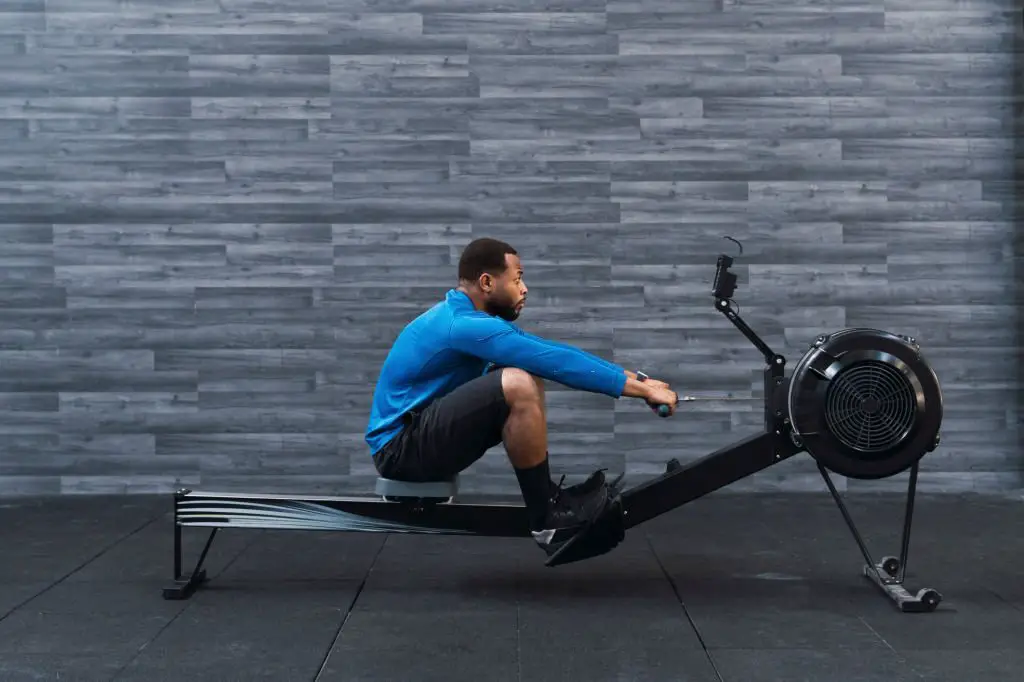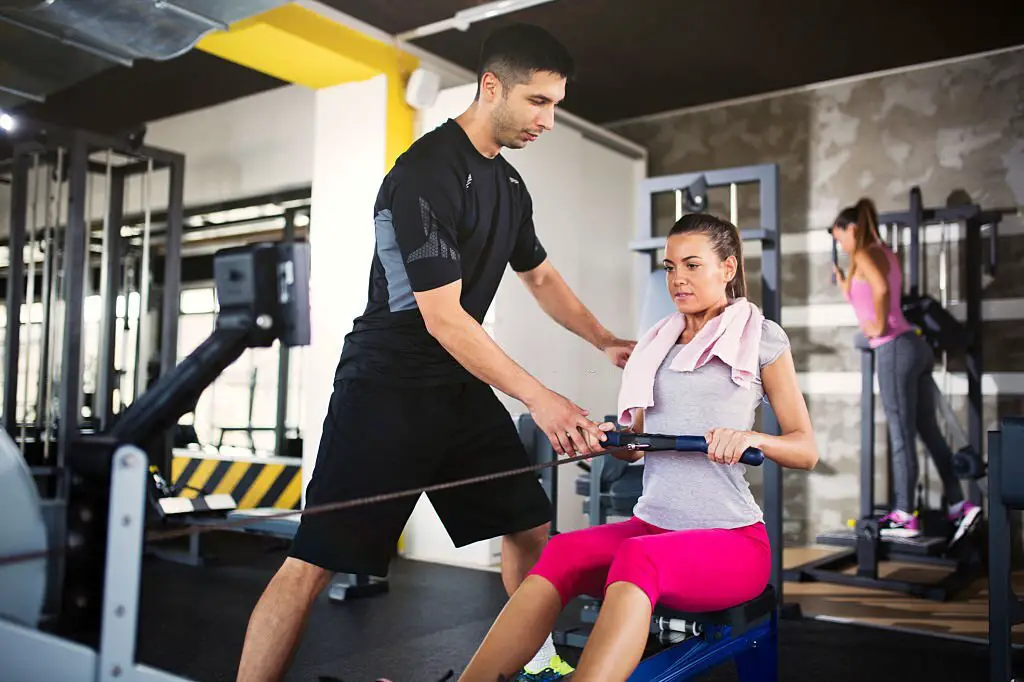If you’re new to the rowing machine, it can be a bit intimidating at first. But fear not! With a little guidance on technique and some beginner workouts, you’ll soon be feeling like a pro. One common question for beginners is how long it will take to row 2,000 meters. In this blog post, we’ll answer that question and provide some tips to help get you started. Let’s dive in!
Table of Contents
Understanding the Rowing Machine

Starting slowly and building endurance is key when beginning a rowing machine exercise routine.
When beginning an exercise routine on the rowing machine, start slowly and focus on building endurance rather than speed or resistance. A great beginner’s workout is a simple 5-10 minute warm-up followed by 20 minutes of consistent rowing at a moderate pace. As you get more comfortable on the machine, gradually increase time or intensity for maximum results!
Components of the Rowing Machine
The seat and slide are two crucial components of the rowing machine that determine your comfort level while working out. The seat should be positioned in a way that allows you to fully extend your legs without straining, and it should also provide enough cushioning for optimal support during long sessions. Meanwhile, the slide enables you to move back and forth smoothly as you engage in each stroke.
Another important component of the rowing machine is the handle and chain. Your grip on the handle should be firm but not too tight, allowing for a steady flow of movement throughout your workout. As for the chain, make sure it’s properly lubricated to reduce friction and ensure smooth operation.
Lastly, don’t overlook footrests and straps – they play a critical role in maintaining stability during intense rowing sessions. Properly adjusting them will help keep your feet securely in place while minimizing unnecessary movements that can throw off your form or even cause injury if done incorrectly.
Benefits of Rowing
When it comes to working out, rowing offers a full-body workout that is hard to beat. Rowing uses multiple muscle groups from your legs, back, and arms for a complete workout that burns calories quickly. Not only does rowing improve overall strength and endurance but also helps tone muscles throughout the body.
Rowing is also an excellent low-impact exercise option for those who want to avoid putting extra strain on joints while still getting a great cardiovascular workout. Unlike running or high-intensity workouts that put pressure on knees and ankles, rowing provides an intense cardio session without any discomfort or pain in the joints. This makes it perfect for people recovering from injury or beginners looking for a gentle yet effective way to get fit. Overall, incorporating regular rows into your fitness routine can help boost heart health by increasing stamina and reducing the risk of heart disease over time.
Technique Tips for Beginners
When it comes to foot positioning on the rowing machine, beginners should start by strapping in their feet and ensuring that the balls of their feet are securely positioned against the footrests. From there, they can adjust the straps as needed for a comfortable fit.
Proper hand placement is also crucial for beginner rowers. Beginners should grip the handles with an overhand grip and ensure that their wrists remain straight throughout each stroke. Additionally, maintaining a relaxed grip will help prevent blisters or discomfort during longer workouts.
Foot Positioning
Adjust the foot straps so they fit snugly over your toes. This will prevent your feet from slipping out of the straps while exercising. Keep your heels down and balls of feet on the machine to maintain balance and stability during rowing movements. Remember, proper form is key to avoid injury or strain on muscles.
The feet should be hip-width apart at all times when using the rowing machine. This stance allows for maximum power generation during each stroke you perform. It also aids in keeping a steady rhythm throughout your workout routine. Keep these tips in mind as you begin your journey with the rowing machine, and watch as you progress toward achieving better technique and stronger workouts!
Hand Placement
Grip the handle with an overhand grip and make sure your knuckles are facing up. This will ensure that you have a strong grip on the handle and prevent your hands from slipping during the rowing motion. Your hands should be shoulder-width apart on the handle, allowing for proper leverage throughout each stroke. Additionally, it’s important to keep your wrists straight and not bent in any direction.
Proper hand placement is crucial to getting the most out of your rowing workouts. Here are some tips:
- Grip the handle with an overhand grip
- Knuckles should face up
- Hands should be shoulder-width apart on the handle
- Wrists should be straight, not bent
By following these guidelines, you’ll be able to maintain a strong grip while also ensuring that your rowing motion is as effective as possible.
Body Positioning
Sit tall with a straight back, leaning slightly forward from the hips to achieve proper body positioning on the rowing machine. Engage your core muscles to stabilize your torso throughout the movement and maintain good posture. Your hips and shoulders should move together in unison during the drive phase for optimal performance.
Proper
- Sit tall with a straight back
- Lean slightly forward from the hips
- Engage core muscles to stabilize the torso throughout the movement
- Hips and shoulders move together in unison during the drive phase
By following these simple guidelines, you’ll be able to establish an effective body position on the rowing machine that will allow you to maximize results while minimizing the risk of injury. Practice this technique regularly until it becomes second nature – happy rowing!
Breathing
Breathing is an important aspect to consider when rowing. Inhale deeply at the starting position (the catch) to prepare your body for the exertion ahead. As you push off (the drive), exhale forcefully, engaging your core muscles and aiding in propelling yourself forward. Finally, inhale again as you return to the starting position, allowing your lungs to fill with air before beginning another stroke.
Remember that proper breathing techniques can help improve both endurance and performance on a rowing machine. Practice these breathing techniques during beginner workouts and gradually incorporate them into more advanced training sessions. With consistent practice, mastering proper breathing will become natural and effortless while on the rowing machine.
Beginner Workouts

Another great beginner workout is the pyramid interval workout. This involves gradually increasing and then decreasing the length of your intervals, building up both strength and endurance over time. Start with shorter intervals of 30 seconds or less before gradually increasing them until you reach one minute in length, then decrease back down again. Remember to take breaks as needed!
20-Minute Endurance Workout
Before starting any workout, it’s important to properly warm up your body. Begin with 5-10 minutes of light cardio, such as jogging or cycling on a stationary bike. Then focus on dynamic stretches that target the muscles you’ll be using during your workout. For rowing, some great options include leg swings and arm circles.
To maintain proper technique during a long endurance workout, aim for a steady pace rather than going all out at the beginning. Focus on keeping your strokes consistent and smooth throughout the entire 20-minute session. Remember to engage your legs and core in addition to pulling with your arms.
Good posture is key when using the rowing machine for an extended period of time. Make sure you’re sitting up straight with your shoulders relaxed and your back engaged throughout the entire motion. Avoid hunching forward or leaning too far back which can lead to injury over time.
Pyramid Interval Workout
Pyramid interval workouts provide a challenging yet effective workout for rowers of all fitness levels. The structure involves gradually increasing and then decreasing the intensity and time intervals during each phase, allowing for short bursts of high-intensity exercise followed by active recovery moments. For beginners, starting with shorter intervals such as 30 seconds on and 30 seconds off can help build endurance while reducing the risk of injury.
To stay motivated throughout the session, it’s essential to focus on proper technique and form while pushing yourself out of your comfort zone. Setting small goals before each phase can also be helpful in achieving a successful pyramid interval workout experience. Remember to listen to your body and take breaks when needed but don’t give up – just like climbing a pyramid takes effort, so does this type of workout!
2,000 Meter Time Trial
When it comes to preparing for your first 2,000-meter time trial on the rowing machine, it’s important to focus on both physical and mental preparation. Physically, make sure you are well-rested and fueled with proper nutrition leading up to the race. Mentally, visualize yourself successfully completing the trial and use positive affirmations.
Maintaining optimal speed throughout your race is crucial for achieving your desired time. One technique that can help is focusing on your breathing – aim for deep inhales followed by powerful exhales as you push through each stroke. Additionally, pay close attention to your form; maintaining a strong posture and keeping a consistent rhythm will also improve speed.
Effective pacing is key when attempting a 2,000-meter time trial. To avoid starting too fast and burning out early in the race, try breaking down the distance into smaller segments and setting achievable goals for each one. Remember to save some energy towards the end of the race so that you have enough left in reserve for a final push towards the finish line!
How Long Will It Take to Row 2,000 Meters?
When it comes to rowing 2,000 meters on a machine, your time can vary depending on several factors. These include your fitness level, technique, and intensity during the workout. On average, beginners may take around 8-10 minutes to complete this distance. Intermediate rowers may aim for a time of 6-8 minutes while advanced rowers could finish it in under 6 minutes.
If you’re looking to improve your time and become more efficient with your strokes, focus on technique first. Work with a coach or watch online tutorials to ensure you have proper form throughout each stroke. Additionally, incorporating high-intensity interval training into your workouts can also help increase speed over time. Remember that progress takes patience and consistency – keep practicing and pushing yourself towards improvement!
Factors That Affect Your Time
Technique, fitness level, age, and gender are all factors that can affect your time on the rowing machine. Here’s how each one can impact your performance:
- Technique:
- Proper form and technique are crucial for efficient rowing. Without it, you’ll waste energy and tire out more quickly. It’s important to learn the correct way to set up on the machine, hold the handle, and perform each part of the stroke.
- Fitness level:
- Your current physical condition plays a big role in how fast you’re able to row. If you’re not used to exercising or have been sedentary for a while, it will take longer to build up endurance than if you already have a base fitness level.
- Age and gender:
- These factors may also come into play when determining your average time. Generally speaking, younger people tend to be faster than older people due to their increased flexibility and recovery ability.
While these factors can impact your time on the machine initially, with practice they become less significant as muscle memory develops over time.
Average Times for Beginner, Intermediate, and Advanced Rowers
For beginners on the rowing machine, a good time to aim for completing 2000 meters is between 8-10 minutes. As you progress and become more comfortable with the technique, intermediate rowers can bring their times down to between 6-8 minutes. For advanced rowers who have honed their skills over time, finishing in under 6 minutes is an achievable goal.
It’s important to remember that these times are just guidelines and everyone’s abilities may differ. Don’t be discouraged if it takes longer than expected at first – consistency in training and proper form will lead to improvements over time. Keep challenging yourself with different intervals and increasing resistance as needed to continue improving your speed on the rowing machine.
Tips for Improving Your Time
Focus on proper technique, incorporate interval training into your workouts and increase resistance gradually over time to improve your time on the rowing machine. Here are some tips for getting the most out of your workout:
- Focus on proper technique:
- Proper posture and form can make a big difference in how efficiently you use energy while rowing. Make sure you maintain an upright position with a straight back throughout the stroke.
- Incorporate interval training into your workouts:
- Alternating between periods of high-intensity exercise and active rest can help improve both endurance and speed. Try doing 30-second sprints followed by 30 seconds of easy rowing, then repeat for several rounds.
- Increase resistance gradually over time:
- As you become more comfortable with the machine, don’t be afraid to challenge yourself by increasing resistance levels slowly but surely.
By following these tips, beginners can start improving their times on the rowing machine without feeling overwhelmed or discouraged. Remember to focus on consistency rather than perfection – progress takes time!

